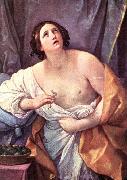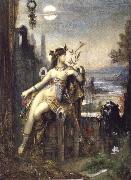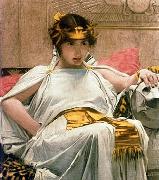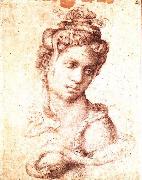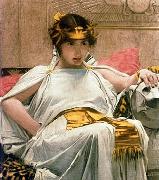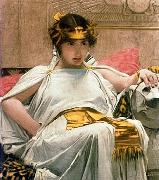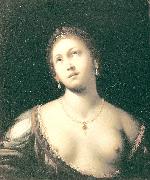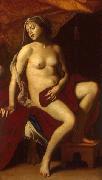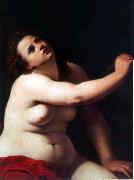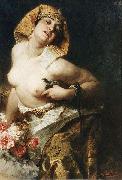Wholesale Oil Painting No Minimum |
|||||||||||
|
|
|||||||||||

|
|||||||||||
|
|
|
||||||||
RENI, GuidoItalian Baroque Era Painter, 1575-1642 Italian painter, draughtsman and etcher. He was one of the greatest and most influential of the 17th-century Italian painters, whose sophisticated and complex art dominated the Bolognese school. A classicizing artist, deeply influenced by Greco-Roman art and by Raphael but also by the mannered elegance of Parmigianino's paintings, he sought an ideal beauty; his work was especially celebrated for its compositional and figural grace. In his religious art he was concerned with the expression of intense emotion, often charged with pathos; according to his biographer Malvasia, he boasted that he 'could paint heads with their eyes uplifted a hundred different ways' to give form to a state of ecstasy or divine inspiration. |
||||||||
|
|
||||||||
Cleopatra
Cleopatra Painting ID:: 8881 |
1635-40
Oil on canvas, 122 x 96 cm
Galleria Palatina (Palazzo Pitti), Florence 1635-40 Oil on canvas, 122 x 96 cm Galleria Palatina (Palazzo Pitti), Florence |
|||||||
|
|
||||||||
Guido Reni1575-1642 Italian Guido Reni Galleries Born in Bologna into a family of musicians, Guido Reni was the son of Daniele Reni and Ginevra de?? Pozzi. As a child of nine, he was apprenticed under the Bolognese studio of Denis Calvaert. Soon after, he was joined in that studio by Albani and Domenichino. He may also have trained with a painter by the name of Ferrantini. When Reni was about twenty years old, the three Calvaert pupils migrated to the rising rival studio, named Accademia degli Incamminati (Academy of the "newly embarked", or progressives), led by Lodovico Carracci. They went on to form the nucleus of a prolific and successful school of Bolognese painters who followed Annibale Carracci to Rome. Like many other Bolognese painters, Reni's painting was thematic and eclectic in style. By late 1601, Reni and Albani had moved to Rome to work with the teams led by Annibale Carracci in fresco decoration of the Farnese Palace. During 1601-1604, his main patron was cardinal Sfondrato. By 1604-1605, he received an independent commission for an altarpiece of the Crucifixion of St. Peter. After a few year sojourn in Bologna, he returned to Rome to become one of the premier painters during the papacy of Paul V (Borghese). From 1607-1614, he was one of the painters patronized by Borghese. Abduction of Deianira, 1620-1621.Reni's frescoed ceiling of the large central hall of garden palace, Casino dell'Aurora located in the grounds of the Palazzo Pallavicini-Rospigliosi, is considered his masterpiece. The casino was originally a pavilion commissioned by Cardinal Scipione Borghese; the rear portion overlooks the Piazza Montecavallo and Palazzo del Quirinale. The massive fresco is framed in quadri riportati and depicts Apollo in his Chariot preceded by Dawn (Aurora) bringing light to the world. The work is restrained in classicism, copying poses from Roman Sarcophagi, and showing far more simplicity and restraint than Carracci's riotous Triumph of Bacchus and Ariadne[5] in the Farnese. Reni in this painting is allies himself more with the sterner Cavaliere d'Arpino,Lanfranco, and Albani "School" of mytho-historic painting, and less with the more crowded frescoes characteristic of Pietro da Cortona. There is little concession to perspective, and the vibrantly colored style is antithetical to the tenebrism of Caravaggio's followers. Payments showed that he was paid in 247 scudi and 54 baiocchi upon completion on 24 September 1616. He also frescoed in Paoline Chapel of Santa Maria Maggiore in Rome as well as the Aldobrandini wings of the Vatican. According to rumor, the pontifical chapel of Montecavallo (Chapel of the Annuciation) was assigned to Reni to paint. However, because he felt underpaid by the ministers, the artist left for Bologna, leaving the role of the preeminent artist in Rome to Domenichino. |
||||||||
|
|
||||||||
|
|
Cleopatra
Cleopatra Painting ID:: 28845 |
mk65
Oil on canvas
48 1/16x38 3/16in
Pitti,Palatine Gallery
mk65 Oil on canvas 48 1/16x38 3/16in Pitti,Palatine Gallery |
||||||
|
|
||||||||
Gustave MoreauFrench 1826-1898 Moreau's main focus was the illustration of biblical and mythological figures. As a painter of literary ideas rather than visual images, he appealed to the imaginations of some Symbolist writers and artists, who saw him as a precursor to their movement. His father, Louis Jean Marie Moreau, was an architect, who recognized his talent. His mother was Adele Pauline des Moutiers. Moreau studied under François-Édouard Picot and became a friend of Th??odore Chass??riau, whose work strongly influenced his own. Moreau carried on a deeply personal 25-year relationship, possibly romantic, with Adelaide-Alexandrine Dureux, a woman whom he drew several times.[1] His first painting was a Piet?? which is now located in the cathedral at Angoul??me. He showed A Scene from the Song of Songs and The Death of Darius in the Salon of 1853. In 1853 he contributed Athenians with the Minotaur and Moses Putting Off his Sandals within Sight of the Promised Land to the Great Exhibition. Oedipus and the Sphinx, one of his first symbolist paintings, was exhibited at the Salon of 1864. Over his lifetime, he produced over 8,000 paintings, watercolors and drawings, many of which are on display in Paris' Mus??e national Gustave Moreau at 14, rue de la Rochefoucauld (IXe arrondissement). The museum is in his former workshop, and was opened to the public in 1903. Andr?? Breton famously used to "haunt" the museum and regarded Moreau as a precursor to Surrealism. He had become a professor at Paris' École des Beaux-Arts in 1891 and counted among his many students the fauvist painters, Henri Matisse and Georges Rouault. Moreau is buried in Paris' Cimeti??re de Montmartre. In Alan Moore's graphic novel, The League of Extraordinary Gentlemen, it is implied that he was a nephew of Doctor Moreau, and he based a few of his paintings on the Doctor's creations. |
||||||||
|
|
||||||||
|
|
Cleopatra
Cleopatra Painting ID:: 40090 |
mk155
c.1887
Watercolor with gouache highlights
40x25cm
mk155 c.1887 Watercolor with gouache highlights 40x25cm |
||||||
|
|
||||||||
John William WaterhouseEnglish Pre-Raphaelite Painter, 1849-1917 English painter. His father was a minor English painter working in Rome. Waterhouse entered the Royal Academy Schools in London in 1870. He exhibited at the Society of British Artists from 1872 and at the Royal Academy from 1874. From 1877 to the 1880s he regularly travelled abroad, particularly to Italy. In the early 1870s he had produced a few uncharacteristic Orientalist keepsake paintings, but most of his works in this period are scenes from ancient history or classical genre subjects, similar to the work of Lawrence Alma-Tadema (e.g. Consulting the Oracle, c. 1882; London, Tate). However, Waterhouse consistently painted on a larger scale than Alma-Tadema. His brushwork is bolder, his sunlight casts harsher shadows and his history paintings are more dramatic. |
||||||||
|
|
||||||||
|
|
Cleopatra
Cleopatra Painting ID:: 61556 |
Cleopatra
1888
Cleopatra 1888 |
||||||
|
|
||||||||
Michelangelo Buonarrotib Caprese 1475 d Rome 1564 Born: March 6, 1475 Caprese, Italy Died: February 18, 1564 Rome, Italy Italian artist Michelangelo was one of the greatest sculptors of the Italian Renaissance and one of its greatest painters and architects. Early life Michelangelo Buonarroti was born on March 6, 1475, in Caprese, Italy, a village where his father, Lodovico Buonarroti, was briefly serving as a Florentine government agent. The family moved back to Florence before Michelangelo was one month old. Michelangelo's mother died when he was six. From his childhood Michelangelo was drawn to the arts, but his father considered this pursuit below the family's social status and tried to discourage him. However, Michelangelo prevailed and was apprenticed (worked to learn a trade) at the age of thirteen to Domenico Ghirlandaio (1449?C1494), the most fashionable painter in Florence at the time. After a year Michelangelo's apprenticeship was broken off. The boy was given access to the collection of ancient Roman sculpture of the ruler of Florence, Lorenzo de' Medici (1449?C1492). He dined with the family and was looked after by the retired sculptor who was in charge of the collection. This arrangement was quite unusual at the time. Early works Michelangelo's earliest sculpture, the Battle of the Centaurs (mythological creatures that are part man and part horse), a stone work created when he was about seventeen, is regarded as remarkable for the simple, solid forms and squarish proportions of the figures, which add intensity to their violent interaction. Soon after Lorenzo died in 1492, the Medici family fell from power and Michelangelo fled to Bologna. In 1494 he carved three saints for the church of San Domenico. They show dense forms, in contrast to the linear forms which were then dominant in sculpture. Rome After returning to Florence briefly, Michelangelo moved to Rome. There he carved a Bacchus for a banker's garden of ancient sculpture. This is Michelangelo's earliest surviving large-scale work, and his only sculpture meant to be viewed from all sides. In 1498 the same banker commissioned Michelangelo to carve the Piet?? now in St. Peter's. The term piet?? refers to a type of image in which Mary supports the dead Christ across her knees. Larger than life size, the Piet?? contains elements which contrast and reinforce each other: vertical and horizontal, cloth and skin, alive and dead, female and male. Florence On Michelangelo's return to Florence in 1501 he was recognized as the most talented sculptor of central Italy. He was commissioned to carve the David for the Florence Cathedral. Michelangelo's Battle of Cascina was commissioned in 1504; several sketches still exist. The central scene shows a group of muscular soldiers climbing from a river where they had been swimming to answer a military alarm. This fusion of life with colossal grandeur henceforth was the special quality of Michelangelo's art. From this time on, Michelangelo's work consisted mainly of very large projects that he never finished. He was unable to turn down the vast commissions of his great clients which appealed to his preference for the grand scale. Pope Julius II (1443?C1513) called Michelangelo to Rome in 1505 to design his tomb, which was to include about forty life-size statues. Michelangelo worked on the project off and on for the next forty years. Sistine Chapel In 1508 Pope Julius II commissioned Michelangelo to decorate the ceiling of the chief Vatican chapel, the Sistine. The traditional format of ceiling painting contained only single figures. Michelangelo introduced dramatic scenes and an original framing system, which was his earliest architectural design. The chief elements are twelve male and female prophets (the latter known as sibyls) and nine stories from Genesis. Michelangelo stopped for some months halfway along. When he returned to the ceiling, his style underwent a shift toward a more forceful grandeur and a richer emotional tension than in any previous work. The images of the Separation of Light and Darkness, and Ezekiel illustrate this greater freedom and mobility. After the ceiling was completed in 1512, Michelangelo returned to the tomb of Julius and carved a Moses and two Slaves. His models were the same physical types he used for the prophets and their attendants in the Sistine ceiling. Julius's death in 1513 halted the work on his tomb. Pope Leo X, son of Lorenzo de' Medici, proposed a marble facade for the family parish church of San Lorenzo in Florence to be decorated with statues by Michelangelo. After four years of quarrying and designing the project was canceled. Medici Chapel In 1520 Michelangelo was commissioned to execute the Medici Chapel for two young Medici dukes. It contains two tombs, each with an image of the deceased and two allegorical (symbolic) figures: Day and Night on one tomb, and Morning and Evening on the other. A library, the Biblioteca Laurenziana, was built at the same time on the opposite side of San Lorenzo to house Pope Leo X's books. The entrance hall and staircase are some of Michelangelo's most astonishing architecture, with recessed columns resting on scroll brackets set halfway up the wall and corners stretched open rather than sealed. Poetry Michelangelo wrote many poems in the 1530s and 1540s. Approximately three hundred survive. The earlier poems are on the theme of Neoplatonic love (belief that the soul comes from a single undivided source to which it can unite again) and are full of logical contradictions and intricate images. The later poems are Christian. Their mood is penitent (being sorrow and regretful); and they are written in a simple, direct style. Last Judgment In 1534 Michelangelo left Florence for the last time, settling in Rome. The next ten years were mainly given over to painting for Pope Paul III (1468?C1549). |
||||||||
|
|
||||||||
|
|
Cleopatra
Cleopatra Painting ID:: 62889 |
1533-34 Black chalk, 35,5 x 25 cm Galleria degli Uffizi, Florence Artist: MICHELANGELO Buonarroti Title: Cleopatra Date: 1501-1550 Italian , graphics : study 1533-34 Black chalk, 35,5 x 25 cm Galleria degli Uffizi, Florence Artist: MICHELANGELO Buonarroti Title: Cleopatra Date: 1501-1550 Italian , graphics : study |
||||||
|
|
||||||||
Frank Bernard Dicksee(b. London, 27 November 1853 - 17 October 1928) was an English Victorian painter and illustrator, best known for his pictures of dramatic historical and legendary scenes. He also was a noted painter of portraits of fashionable women, which helped to bring him success in his own time. Dicksee's father, Thomas Dicksee, was a painter who taught Frank as well as his brother Herbert and his sister Margaret from a young age. Dicksee enrolled in the Royal Academy in 1870 and achieved early success. He was elected to the Academy in 1891 and became its President in 1924. He was knighted in 1925, and named to the Royal Victorian Order by King George V in 1927. Dicksee painted the piece 'The Funeral of a Viking' in 1893, which now resides in Manchester City Art Gallery, having been there since 1928 when it was presented by Arthur Burton ESQ in memory of his mother to the Corporation of Manchester. Victorian critics gave it both positive and negative reviews, for its perfection as a showpiece and for its dramatic and somewhat staged setting, respectively. The painting was used by Swedish Viking/Black metal band Bathory for the cover of their 1990 album, Hammerheart. |
||||||||
|
|
||||||||
|
|
Cleopatra
Cleopatra Painting ID:: 71835 |
Oil on canvas
Oil on canvas |
||||||
|
|
||||||||
John William WaterhouseEnglish Pre-Raphaelite Painter, 1849-1917 English painter. His father was a minor English painter working in Rome. Waterhouse entered the Royal Academy Schools in London in 1870. He exhibited at the Society of British Artists from 1872 and at the Royal Academy from 1874. From 1877 to the 1880s he regularly travelled abroad, particularly to Italy. In the early 1870s he had produced a few uncharacteristic Orientalist keepsake paintings, but most of his works in this period are scenes from ancient history or classical genre subjects, similar to the work of Lawrence Alma-Tadema (e.g. Consulting the Oracle, c. 1882; London, Tate). However, Waterhouse consistently painted on a larger scale than Alma-Tadema. His brushwork is bolder, his sunlight casts harsher shadows and his history paintings are more dramatic. |
||||||||
|
|
||||||||
|
|
Cleopatra
Cleopatra Painting ID:: 71947 |
1888
Oil on canvas
1888 Oil on canvas |
||||||
|
|
||||||||
Frank Bernard Dicksee(b. London, 27 November 1853 - 17 October 1928) was an English Victorian painter and illustrator, best known for his pictures of dramatic historical and legendary scenes. He also was a noted painter of portraits of fashionable women, which helped to bring him success in his own time. Dicksee's father, Thomas Dicksee, was a painter who taught Frank as well as his brother Herbert and his sister Margaret from a young age. Dicksee enrolled in the Royal Academy in 1870 and achieved early success. He was elected to the Academy in 1891 and became its President in 1924. He was knighted in 1925, and named to the Royal Victorian Order by King George V in 1927. Dicksee painted the piece 'The Funeral of a Viking' in 1893, which now resides in Manchester City Art Gallery, having been there since 1928 when it was presented by Arthur Burton ESQ in memory of his mother to the Corporation of Manchester. Victorian critics gave it both positive and negative reviews, for its perfection as a showpiece and for its dramatic and somewhat staged setting, respectively. The painting was used by Swedish Viking/Black metal band Bathory for the cover of their 1990 album, Hammerheart. |
||||||||
|
|
||||||||
|
|
Cleopatra
Cleopatra Painting ID:: 73096 |
Title Cleopatra
Date
Medium Oil on canvas
Current location Private collection
cyf Title Cleopatra Date Medium Oil on canvas Current location Private collection cyf |
||||||
|
|
||||||||
John William WaterhouseEnglish Pre-Raphaelite Painter, 1849-1917 English painter. His father was a minor English painter working in Rome. Waterhouse entered the Royal Academy Schools in London in 1870. He exhibited at the Society of British Artists from 1872 and at the Royal Academy from 1874. From 1877 to the 1880s he regularly travelled abroad, particularly to Italy. In the early 1870s he had produced a few uncharacteristic Orientalist keepsake paintings, but most of his works in this period are scenes from ancient history or classical genre subjects, similar to the work of Lawrence Alma-Tadema (e.g. Consulting the Oracle, c. 1882; London, Tate). However, Waterhouse consistently painted on a larger scale than Alma-Tadema. His brushwork is bolder, his sunlight casts harsher shadows and his history paintings are more dramatic. |
||||||||
|
|
||||||||
|
|
Cleopatra
Cleopatra Painting ID:: 73362 |
Date 1888
Medium Oil on canvas
Dimensions X cm
cyf Date 1888 Medium Oil on canvas Dimensions X cm cyf |
||||||
|
|
||||||||
Francesco Cairo(1607-1665) was an Italian painter active in Baroque Lombardy and Piedmont. He was born and died in Milan. It is not known where he obtained his early training though he is strongly influenced by the circle of il Morazzone, in works such as the Saint Teresa altarpiece in the Certosa di Pavia. In 1633, Cairo moved to Turin to work as a court painter, including portraits, to Vittorio Amedeo I of the House of Savoy. Between 1637-1638, Cairo travelled to Rome, where he encounters the works of Pietro da Cortona, Guido Reni and of the Caravaggisti. He returns to Lombardy to complete altarpieces for the Certosa of Pavia and a church at Casalpusterlengo. He painted a St. Theresa for San Carlo in Venice. Between 1646-1649, he returns to Turin, and paints an altarpiece for Savigliano and the church of San Salvario. He is also known as Il Cavaliere del Cairo, because in Turin, he received the order of SS. Lazarus and Maurice in recognition of his merit. Many of his works are eccentric depictions of religious ecstasies; the saints appear liquefied and contorted by piety. He often caps them with exuberant, oriental turbans. |
||||||||
|
|
||||||||
|
|
Cleopatra
Cleopatra Painting ID:: 74509 |
17th century
Oil on canvas
57 X 49 cm (22.44 X 19.29 in)
cjr 17th century Oil on canvas 57 X 49 cm (22.44 X 19.29 in) cjr |
||||||
|
|
||||||||
Francesco Cairo(1607-1665) was an Italian painter active in Baroque Lombardy and Piedmont. He was born and died in Milan. It is not known where he obtained his early training though he is strongly influenced by the circle of il Morazzone, in works such as the Saint Teresa altarpiece in the Certosa di Pavia. In 1633, Cairo moved to Turin to work as a court painter, including portraits, to Vittorio Amedeo I of the House of Savoy. Between 1637-1638, Cairo travelled to Rome, where he encounters the works of Pietro da Cortona, Guido Reni and of the Caravaggisti. He returns to Lombardy to complete altarpieces for the Certosa of Pavia and a church at Casalpusterlengo. He painted a St. Theresa for San Carlo in Venice. Between 1646-1649, he returns to Turin, and paints an altarpiece for Savigliano and the church of San Salvario. He is also known as Il Cavaliere del Cairo, because in Turin, he received the order of SS. Lazarus and Maurice in recognition of his merit. Many of his works are eccentric depictions of religious ecstasies; the saints appear liquefied and contorted by piety. He often caps them with exuberant, oriental turbans. |
||||||||
|
|
||||||||
|
|
Cleopatra
Cleopatra Painting ID:: 76034 |
Date 17th century
Medium Oil on canvas
Dimensions 57 ?? 49 cm (22.4 ?? 19.3 in)
cyf Date 17th century Medium Oil on canvas Dimensions 57 ?? 49 cm (22.4 ?? 19.3 in) cyf |
||||||
|
|
||||||||
Massimo Stanzione(also called Stanzioni; c. 1586 - c. 1656) was an Italian Baroque painter, mainly active in Naples. Massimo Stanzione was an Italian Baroque painter. Born in Naples in 1586, Massimo was greatly influenced by Michelangelo Merisi da Caravaggio, but what earned him the nickname of The Neapolitan Guido Reni was his sophisticated and graceful style. The thing that distinguished Massimo art from Carravaggism was that he combined Caravaggio dramatically lit and brutally realistic style with the classical and lyrical manner of Bolognesi painters. Though his preliminary training is uncertain, it is thought that he studied with Fabrizio Santafede; however, most of the influence he received was from Caravaggio. Art historians believe that Stanzione developed his career as an artist in Rome. It is thought that he bagan his career as a portraitist. Some of his most famous works include Portrait of a Woman in Popular Costume, and Portrait of Jerome Banks. Between 1617 and 1630, it is believed that he traveled between the papal city and his hometown of Naples exploring different styles of art. Also influenced by Caravaggio were Artemisia Gentileschi, Simon Vouet, and Carlo Saraceni. During Stanzione career a movement that changed the style of art was formed. Stanzione was a part of this movement. This movement transformed the dark, contrasted Caravaggio-styled art into Bolognese colorism and soft art. |
||||||||
|
|
||||||||
|
|
Cleopatra
Cleopatra Painting ID:: 76126 |
Date 1630s
Medium Oil on canvas
Dimensions 169 ?? 100 cm (66.5 ?? 39.4 in)
cyf Date 1630s Medium Oil on canvas Dimensions 169 ?? 100 cm (66.5 ?? 39.4 in) cyf |
||||||
|
|
||||||||
Artemisia gentileschi1593-1652 was an Italian Early Baroque painter, today considered one of the most accomplished painters in the generation influenced by Caravaggio. In an era when women painters were not easily accepted by the artistic community, she was the first female painter to become a member of the Accademia di Arte del Disegno in Florence. She was one of the first female artists to paint historical and religious paintings, at a time when such heroic themes were considered beyond a woman's reach. Artemisia Gentileschi was born in Rome, July 8, 1593, the first child of the Tuscan painter Orazio Gentileschi, one of the best representatives of the school of Caravaggio. Artemisia was introduced to painting in her father's workshop, showing much more talent than her brothers, who worked alongside her. She learned drawing, how to mix color and how to paint. Since her father's style took inspiration from Caravaggio during that period, her style was just as heavily influenced in turn. But her approach to subject matter was different from her father's, as her paintings are highly naturalistic, where Orazio's are idealized. The first work of the young 17-year-old Artemisia (even if many at the time suspected that she was helped by her father) was the Susanna e i Vecchioni (Susanna and the Elders) (1610, Schönborn collection in Pommersfelden). The picture shows how Artemisia assimilated the realism of Caravaggio without being indifferent to the language of the Bologna school (which had Annibale Carracci among its major artists). It is one of the few Susanna paintings showing the two men planning their sexual harassment. It is likely that Artemisia had been sexually harrassed and painted Susanna as a reflection. In 1612, despite her early talent, Artemisia was denied access to the all-male professional academies for art. At the time, her father was working with Agostino Tassi to decorate the vaults of Casino della Rose inside the Pallavicini Rospigliosi Palace in Rome, so Orazio hired the painter to tutor his daughter privately. During this tutelage, Tassi raped Artemisia. Another man, Cosimo Quorlis had helped Tassi with the rape. After the initial rape, Artemisia continued to have sexual relations with Tassi, with the expectation that they were going to be married. However, Tassi reneged on his promise to marry Artemisia after he heard the rumor that she was having an affair with another man. Quorlis had threatened that if he could not have her, he would publicly humiliate her. Orazio pressed charges against Tassi only after he learned that Artemisia and Tassi were not going to be married. Orazio also claimed that Tassi stole a painting of Judith from the Gentileschi household. The major issue of this trial was the fact that Tassi had deflowered Artemisia. If Artemisia had not been a virgin before Tassi raped her, the Gentileschis would not be able to press charges. In the ensuing 7-month trial, it was discovered that Tassi had planned to murder his wife, had enjoined in adultery with his sister-in-law and planned to steal some of Orazio??s paintings. During the trial Artemisia was given a gynecological examination and was tortured using a device made of thongs wrapped around the fingers and tightened by degrees ?? a particularly cruel torture to a painter. Both procedures were used to corroborate the truth of her allegation, the torture device used due to the belief that if a person can tell the same story under torture as without it, the story must be true. At the end of the trial Tassi was imprisoned for one year. The trial has subsequently influenced the feminist view of Artemisia Gentileschi during the late 20th century. The painting Giuditta che decapita Oloferne (Judith beheading Holofernes) (1612 - 1613), displayed in the Capodimonte Museum of Naples, is impressive for the violence portrayed, and has been interpreted as a wish for psychological revenge for the violence Artemisia had suffered. One month after the trial, in order to restore her honor, Orazio arranged for his daughter to marry Pierantonio Stiattesi, a modest artist from Florence. Shortly afterwards the couple moved to Florence, where Artemisia received a commission for a painting at Casa Buonarroti and became a successful court painter, enjoying the patronage of the Medici family and Charles I. It has been proposed that during this period Artemisia also painted the Madonna col Bambino (The Virgin and Child), currently in the Spada Gallery, Rome. While in Florence, |
||||||||
|
|
||||||||
|
|
Cleopatra
Cleopatra Painting ID:: 93319 |
oil on canvas
cjr oil on canvas cjr |
||||||
|
|
||||||||
Gyula BenczurGyula Benczur (1844 - 1920) was a Hungarian painter and pedagogue. He won international success with his first few paintings, winning several competitions. He assisted Karl von Piloty with the frescoes of Maximilianeum and Rathaus in Munich. He also illustrated books by the great German writer, Friedrich Schiller. He was commissioned by the Bavarian king Ludwig II to paint Rococo themes. Later he was offered numerous international teaching positions, including offers in Prague and Weimar, but accepted a position in Munich, one of his most distinguished pupils being the Swiss-born American painter Adolfo Meller-Ury. Benczur was later a favorite among the Hungarian upper-class, painting numerous portraits of kings and aristocrats. He was considered a rival in historical painting to Makart. During his lifetime, Benczur won numerous awards. His self-portrait is on display at the Uffizi Gallery in Florence. |
||||||||
|
|
||||||||
|
|
Cleopatra
Cleopatra Painting ID:: 93531 |
Date 1911(1911)
Medium oil on canvas
Dimensions 69 x 100 cm (27.2 x 39.4 in)
TTD Date 1911(1911) Medium oil on canvas Dimensions 69 x 100 cm (27.2 x 39.4 in) TTD |
||||||
|
|
||||||||
|
Gyula Benczur Gyula Benczur (1844 - 1920) was a Hungarian painter and pedagogue. He won international success with his first few paintings, winning several competitions. He assisted Karl von Piloty with the frescoes of Maximilianeum and Rathaus in Munich. He also illustrated books by the great German writer, Friedrich Schiller. He was commissioned by the Bavarian king Ludwig II to paint Rococo themes. Later he was offered numerous international teaching positions, including offers in Prague and Weimar, but accepted a position in Munich, one of his most distinguished pupils being the Swiss-born American painter Adolfo Meller-Ury. Benczur was later a favorite among the Hungarian upper-class, painting numerous portraits of kings and aristocrats. He was considered a rival in historical painting to Makart. During his lifetime, Benczur won numerous awards. His self-portrait is on display at the Uffizi Gallery in Florence. Cleopatra Date 1911(1911) Medium oil on canvas Dimensions 69 x 100 cm (27.2 x 39.4 in) TTD |
||||||||
|
|
||||||||
|
Prev Next
|
||||||||
|
|
||||||||
|
Related Paintings to Gyula Benczur :. |
||||||||
|
|
||||||||
|
CONTACT US |
